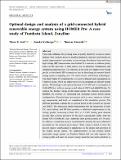Optimal design and analysis of a grid-connected hybrid renewable energy system using HOMER Pro: A case study of Tumbatu Island, Zanzibar

View/
Date
2024-04-04Author
Said, Thani
Kichonge, Baraka
Kivevele, Thomas
Metadata
Show full item recordAbstract
This study addresses the pressing issue of quality electricity access in remote regions, with a specific focus on Tumbatu Island in Tanzania. Most studies on quality improvement concentrate on low-voltage distribution lines and leave high-voltage (HV) transmission lines behind. It is essential to address quality issues in HV lines due to their critical role in electricity transmission and distribution infrastructure. The objective of the study is to improve the voltage profile on the island's HV transmission line by identifying the optimal hybrid energy system comprising solar PV, wind turbine, and battery technologies. The study begins by presenting the total power demand and consumption on Tumbatu Island, which are important factors in designing an efficient energy system. The findings reveal a power demand of 7173 kW and a consumption of 28540 kWh/day, with an average scaled value of 1507.9 and 6000 kWh/day. To achieve the desired voltage profile improvement, the research incorporates HOMER Pro software for simulating and analyzing various hybrid system configurations. Essential input parameters, such as costs, resources, technology components, and load, are considered in the simulation process. The software generates a ranked list of options based on the system's net present cost (NPC). The simulation results demonstrate that the integration of solar PV, wind turbine, and HV lines provides a substantial improvement in the voltage profile, increasing it from 29.6 to 31.23 kV during peak demand periods. This solution proves to be the most economically viable, with the lowest NPC of $4,003,851 and a relatively short payback period of 3.79 years. In addition, a sensitivity analysis is performed to identify the most influential parameter in the system's performance. Wind speed is found to have the greatest impact, emphasizing its significance in the design and operation of the hybrid energy system. The implementation of this optimal hybrid renewable energy system on Tumbatu Island will not only improve the voltage profile and meet the island's energy needs but also shall contribute to global efforts in reducing pollution and the cost of electricity to the Tumbatu Island population. Moreover, it addresses the current and future demands for clean energy, underlining its importance in achieving sustainable and accessible electricity in sub-Saharan Africa and beyond.
